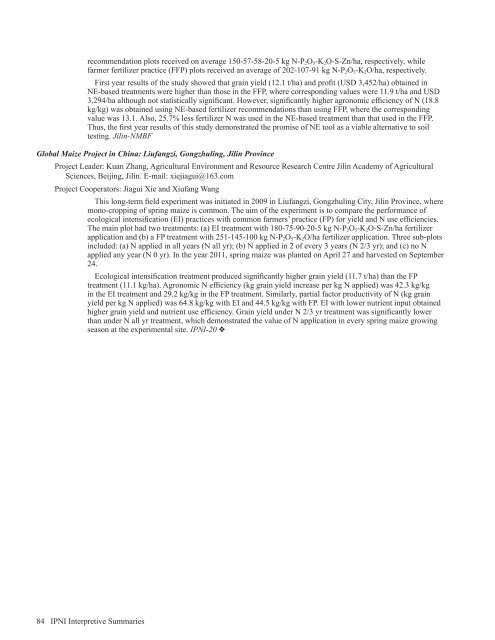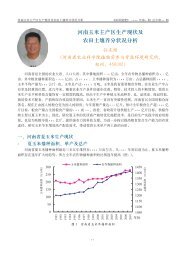Americas and Oceania Group - International Plant Nutrition Institute
Americas and Oceania Group - International Plant Nutrition Institute
Americas and Oceania Group - International Plant Nutrition Institute
You also want an ePaper? Increase the reach of your titles
YUMPU automatically turns print PDFs into web optimized ePapers that Google loves.
ecommendation plots received on average 150-57-58-20-5 kg N-P 2 O 5 -K 2 O-S-Zn/ha, respectively, while<br />
farmer fertilizer practice (FFP) plots received an average of 202-107-91 kg N-P 2 O 5 -K 2 O/ha, respectively.<br />
First year results of the study showed that grain yield (12.1 t/ha) <strong>and</strong> profit (USD 3,452/ha) obtained in<br />
NE-based treatments were higher than those in the FFP, where corresponding values were 11.9 t/ha <strong>and</strong> USD<br />
3,294/ha although not statistically significant. However, significantly higher agronomic efficiency of N (18.8<br />
kg/kg) was obtained using NE-based fertilizer recommendations than using FFP, where the corresponding<br />
value was 13.1. Also, 25.7% less fertilizer N was used in the NE-based treatment than that used in the FFP.<br />
Thus, the first year results of this study demonstrated the promise of NE tool as a viable alternative to soil<br />
testing. Jilin-NMBF<br />
Global Maize Project in China: Liufangzi, Gongzhuling, Jilin Province<br />
Project Leader: Kuan Zhang, Agricultural Environment <strong>and</strong> Resource Research Centre Jilin Academy of Agricultural<br />
Sciences, Beijing, Jilin. E-mail: xiejiagui@163.com<br />
Project Cooperators: Jiagui Xie <strong>and</strong> Xiufang Wang<br />
This long-term field experiment was initiated in 2009 in Liufangzi, Gongzhuling City, Jilin Province, where<br />
mono-cropping of spring maize is common. The aim of the experiment is to compare the performance of<br />
ecological intensification (EI) practices with common farmers’ practice (FP) for yield <strong>and</strong> N use efficiencies.<br />
The main plot had two treatments: (a) EI treatment with 180-75-90-20-5 kg N-P 2 O 5 -K 2 O-S-Zn/ha fertilizer<br />
application <strong>and</strong> (b) a FP treatment with 251-145-100 kg N-P 2 O 5 -K 2 O/ha fertilizer application. Three sub-plots<br />
included: (a) N applied in all years (N all yr); (b) N applied in 2 of every 3 years (N 2/3 yr); <strong>and</strong> (c) no N<br />
applied any year (N 0 yr). In the year 2011, spring maize was planted on April 27 <strong>and</strong> harvested on September<br />
24.<br />
Ecological intensification treatment produced significantly higher grain yield (11.7 t/ha) than the FP<br />
treatment (11.1 kg/ha). Agronomic N efficiency (kg grain yield increase per kg N applied) was 42.3 kg/kg<br />
in the EI treatment <strong>and</strong> 29.2 kg/kg in the FP treatment. Similarly, partial factor productivity of N (kg grain<br />
yield per kg N applied) was 64.8 kg/kg with EI <strong>and</strong> 44.5 kg/kg with FP. EI with lower nutrient input obtained<br />
higher grain yield <strong>and</strong> nutrient use efficiency. Grain yield under N 2/3 yr treatment was significantly lower<br />
than under N all yr treatment, which demonstrated the value of N application in every spring maize growing<br />
season at the experimental site. IPNI-20 v<br />
84 IPNI Interpretive Summaries

















